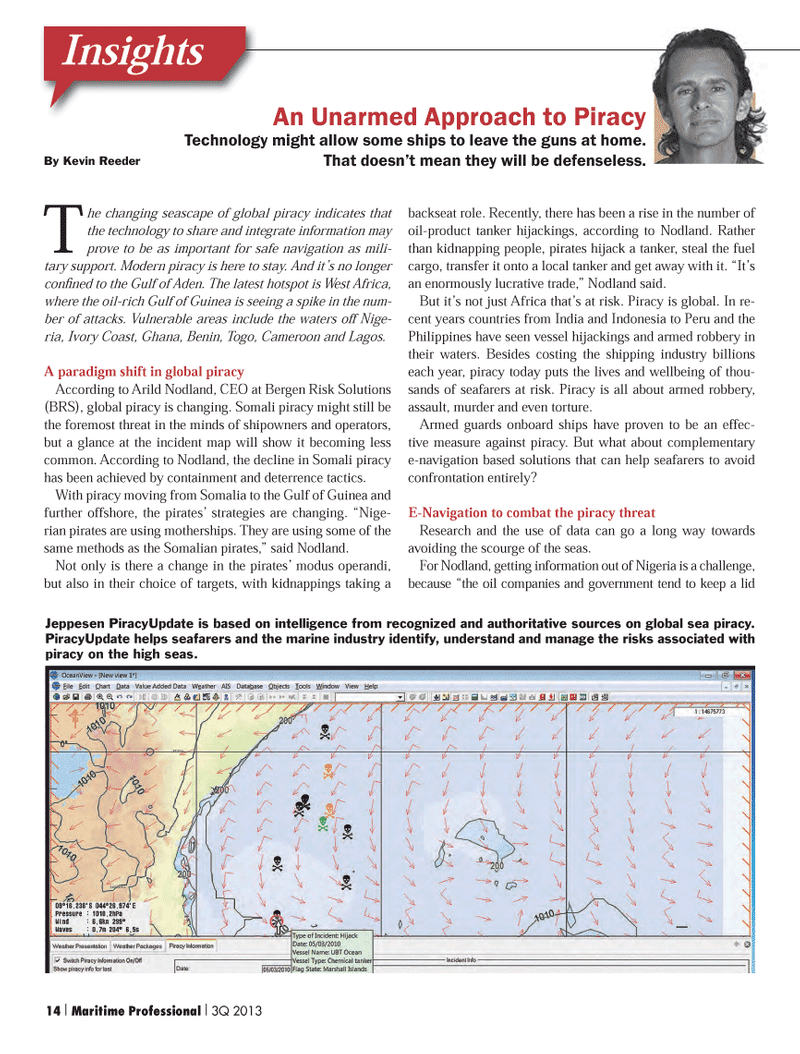
Page 14: of Maritime Logistics Professional Magazine (Q3 2013)
Training & Security
Read this page in Pdf, Flash or Html5 edition of Q3 2013 Maritime Logistics Professional Magazine
InsightsAn Unarmed Approach to Piracy Technology might allow some ships to leave the guns at home. That doesn?t mean they will be defenseless. By Kevin ReederThe changing seascape of global piracy indicates that the technology to share and integrate information may prove to be as important for safe navigation as mili- tary support. Modern piracy is here to stay. And it?s no longer con ned to the Gulf of Aden. The latest hotspot is West Africa, where the oil-rich Gulf of Guinea is seeing a spike in the num- ber of attacks. Vulnerable areas include the waters off Nige- ria, Ivory Coast, Ghana, Benin, Togo, Cameroon and Lagos. A paradigm shift in global piracyAccording to Arild Nodland, CEO at Bergen Risk Solutions (BRS), global piracy is changing. Somali piracy might still be the foremost threat in the minds of shipowners and operators, but a glance at the incident map will show it becoming less common. According to Nodland, the decline in Somali piracy has been achieved by containment and deterrence tactics. With piracy moving from Somalia to the Gulf of Guinea and further offshore, the pirates? strategies are changing. ?Nige- rian pirates are using motherships. They are using some of the same methods as the Somalian pirates,? said Nodland. Not only is there a change in the pirates? modus operandi, but also in their choice of targets, with kidnappings taking a backseat role. Recently, there has been a rise in the number of oil-product tanker hijackings, according to Nodland. Rather than kidnapping people, pirates hijack a tanker, steal the fuel cargo, transfer it onto a local tanker and get away with it. ?It?s an enormously lucrative trade,? Nodland said. But it?s not just Africa that?s at risk. Piracy is global. In re- cent years countries from India and Indonesia to Peru and the Philippines have seen vessel hijackings and armed robbery in their waters. Besides costing the shipping industry billions each year, piracy today puts the lives and wellbeing of thou- sands of seafarers at risk. Piracy is all about armed robbery, assault, murder and even torture. Armed guards onboard ships have proven to be an effec- tive measure against piracy. But what about complementary e-navigation based solutions that can help seafarers to avoid confrontation entirely?E-Navigation to combat the piracy threat Research and the use of data can go a long way towards avoiding the scourge of the seas. For Nodland, getting information out of Nigeria is a challenge, because ?the oil companies and government tend to keep a lid Jeppesen PiracyUpdate is based on intelligence from recognized and authoritative sources on global sea piracy. PiracyUpdate helps seafarers and the marine industry identify, understand and manage the risks associated with piracy on the high seas.14 I Maritime Professional I 3Q 2013MP #3 1-17.indd 14MP #3 1-17.indd 149/10/2013 10:37:36 AM9/10/2013 10:37:36 AM

 13
13

 15
15
